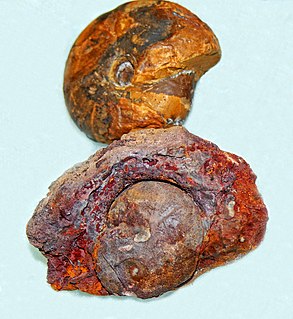
Goniatids, informally Goniatites, are ammonoid cephalopods that form the order Goniatitida, derived from the more primitive Agoniatitida during the Middle Devonian some 390 million years ago. Goniatites (goniatitida) survived the Late Devonian extinction to flourish during the Carboniferous and Permian only to become extinct at the end of the Permian some 139 million years later.
Alaoceras is an ammonoid cephalopod from the upper Paleozoic included in the goniatitid family Cravenoceratidae, named by Ruzhentsev & Bogoslovskaya in 1971.
Arkanites is a goniatitid ammonite that lived during the Early Pennsylvanian that has been found in Arkansas and Oklahoma in the U.S.
Donetzoceras is a genus belonging to the goniatitid family Gonioglyphioceratidae ; extinct ammonoids which are shelled cephalopods more closely related to squid, octopus and other coleoids than to the superficially similar Nautilus
Beyrichoceras is a genus belonging to the Goniatitid family, Muensteroceratidae , a group of ammonoids, extinct shelled cephalopods related to belemnites and recent coleoids and more distantly to the nautiloids

Beyrichoceras is a genus belonging to the Goniatitid family, Maxigoniatitidae that lived during the Mississippian Period
Pseudohaloritidae is the larger of two families that form the goniatitid superfamily Pseudohaloritoidea, the other being the monogenerc Maximitidae. They are part of the vast array of shelled cephalopods known as ammonoids that are more closely related to squids, belemnites, octopuses, and cuttlefish, than to the superficially similar Nautilus.
The Cravenoceratidae is one of six families included in the ammonoid superfamily Neoglyphioceratoidea, which lived during the latter part of the Paleozoic era.
Prolecanitida is an order of extinct ammonoid cephalopods with discoidal to thinly lenticular shells with goniatitic or ceratitic sutures and which retained the simple retrochoanitic siphuncle with backward extending septal necks. As typical for ammonoids the siphuncle is along the ventral margin. Prolecanitids form a relatively small and stable order within the Ammonoidea with 43 named genera and about 1250 species, but with a long-ranging lineage of about 108 m.y. stretching from the Lower Carboniferous to the Triassic. Although not as diverse as their goniatitid contemporaries, the Prolecanatida provided the stock from which all later Mesozoic ammonoids were derived.
The Daraelitidae form a family in the ammonoid order Prolecanitida from the Upper Mississippian - Middle Permian characterized by discoidal shells with no prominent sculpture, moderately large umbilicus, and goniatitic or ceratitic sutures with a trifid ventral lobe and few auxiliary lobes.

Agoniatitida, also known as the Anarcestida, is the ancestral order within the cephalopod subclass Ammonoidea originating from bactritoid nautiloids, that lived in what would become Africa, Asia, Australia, Europe, and North America during the Devonian from about the lower boundary of Zlichovian stage into Taghanic event during upper middle Givetian, existing for approximately 25 million years.

Grypoceratidae is the longest-lived family of the Trigonoceratoidea, or of the near equivalent Centroceratina; members of the Nautilida from the Upper Paleozoic and Triassic.
The Uddenitinae a subfamily of the Medlicottiidae, a family of ammonoid cephalopods included in the Prolecanitida. The Uddenitinae, proposed by Miller and Furnish, and known from the Pennsylvanian and Lower Permian, are transitional between the ancestral Pronoritidae and the more traditional medlicottiids
Biloclymenia is a genus in the ammonoid order Clymeniida which is characterized by a dorsal retrosiphonitic siphuncle with long adapically pointing septal necks.
Bisatoceras is a late Paleozoic Ammonoidea; a member of the goniatitid family Bisatoceratidae.
Neoglaphyrites is a gonititid ammonite that lived during the latest Pennsylvanian and early Permian. Its shell is ellipsoidal and moderately involute; the umbilicus deep and typically less than 15 per cent of the shell diameter but in some species closer to 20 per cent. Delicate growth lines forming ventral and lateral sinuses and ventrolateral and dorsolateral salients have been found on Canadian Arctic specimens. The suture is characterized by the ventral lobe split into two broad prongs that are separated by a high median ventral saddle; prongs closely approximate the width of the first lateral lobe. The first lateral saddle is evenly rounded and is nearly symmetrical. The umbilical lobe is V-shaped and internal lobes are deep and narrow.
Pronorites is a prolecanitid genus from the middle and upper Carboniferous, upper Mississippian and Pennsylvanian. Distribution is wide spread.
Masonoceras is a genus of Karagondoceratids from Lower Mississippian strata, the shell of which is thinly subdiscoidal to discoidal with an acute ventral margin in late ontogeny. Whorls are strongly embracing, umbilicus narrow to occluded. The mature external suture contains a wide trifid ventral lobe, the flanking prongs longer that the medial, an asymmetrically rounded lateral saddle and a deeper asymmetric pointed lateral lobe. Internal molds of the type, Mesoceras Kentuckiense show presence of a broad hyponomic sinus flanked by high rounded vantrolateral salients.
Eowellerites is genus of ammonoid cephalopods belonging to the Welleritidae family. Species belonging to this genus lived in middle Pennsylvanian (Moscovian). Its fossils were found in USA and Japan. It had thinly discoidal shells with a quite wide umbilicus (U/D = 0.3 - 0.5). While in juvenile stages (up to 15 mm in diameter) venter is moderately rounded, it becomes slightly rounded to flattened when becoming mature (100 mm in diameter). 12-lobed suture has adventitious lobe on the first lateral saddle and is also characterized by an addition of an umbilical lobe. Sutural formula is (V1 V1) L1 L (U1 U2): I D. It has evolved from Winslowoceras henbesti and gave rise to genus Wellerites.





